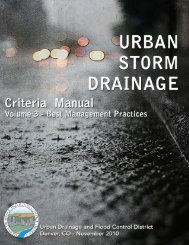BMP Monitoring Sites - Urban Drainage and Flood Control District
BMP Monitoring Sites - Urban Drainage and Flood Control District
BMP Monitoring Sites - Urban Drainage and Flood Control District
You also want an ePaper? Increase the reach of your titles
YUMPU automatically turns print PDFs into web optimized ePapers that Google loves.
UDFCD <strong>BMP</strong> MONITORING SITES<br />
Orchard Pond EDB<br />
A. Top Stage: The top stage should be one or more<br />
feet deep with its bottom sloped at 1 to 2 percent<br />
toward the trickle flow channel.<br />
B. Bottom Stage: The dry weather water surface of the<br />
active surcharge volume of the bottom stage should<br />
be 0.5 feet or more below the bottom of the top stage,<br />
but no less than 4-inches below the invert of the<br />
upstream trickle channel, <strong>and</strong> store no less than 0.5<br />
percent of the WQCV.<br />
Provide a permanent micro-pool below the active<br />
storage volume of the lower stage in front of the outlet.<br />
The pool should be ½ the depth of the top stage depth<br />
described above, or 2.5 feet, whichever results in the<br />
larger depth. Line bottom of the micro-pool with concrete<br />
paving at least 6-inches thick or with grouted boulders<br />
grouted to the top of the boulders.<br />
Low-Flow Channel<br />
Basin Side Slopes<br />
Dam Embankment<br />
Conveys low flows from the forebay to the<br />
bottom stage. A concrete-bottomed<br />
channel is recommended to provide<br />
maintainability. Otherwise line its sides with<br />
buried Type VL soil riprap <strong>and</strong> bottom with<br />
concrete. Make it at least 4-inches deep if<br />
concrete lined sides <strong>and</strong> 8-inches if buried<br />
riprap sides are used. At a minimum provide capacity<br />
equal to twice the release capacity at the upstream<br />
forebay outlet.<br />
Basin side slopes should be stable <strong>and</strong> gentle to facilitate<br />
maintenance <strong>and</strong> access. Side slopes should be no<br />
steeper than 4:1 <strong>and</strong> the use of flatter slopes is<br />
recommended: the flatter, the better <strong>and</strong> safer.<br />
Design the embankment not to fail during a 100-year <strong>and</strong><br />
larger storms. Embankment slopes should be no steeper<br />
than 3:1, preferably 4:1 or flatter, <strong>and</strong> planted with turf<br />
forming grasses. Poorly compacted native soils should<br />
be excavated <strong>and</strong> replaced.<br />
Embankment soils should be<br />
compacted to at least 95<br />
percent of their maximum<br />
density according to ASTM D<br />
698-70 (Modified Proctor).<br />
Spillway structures <strong>and</strong>
















